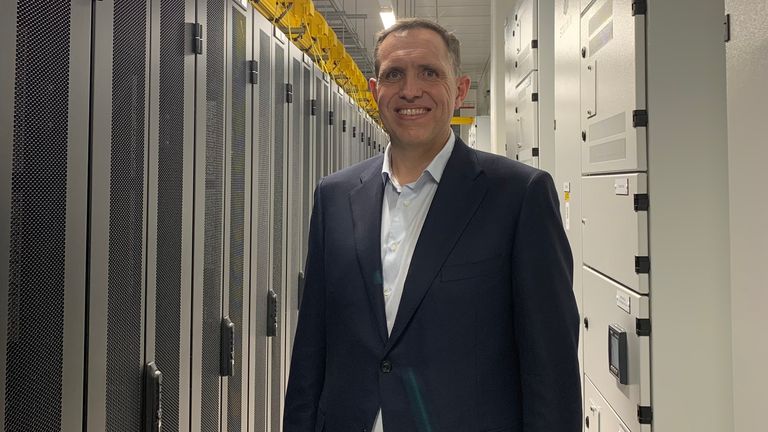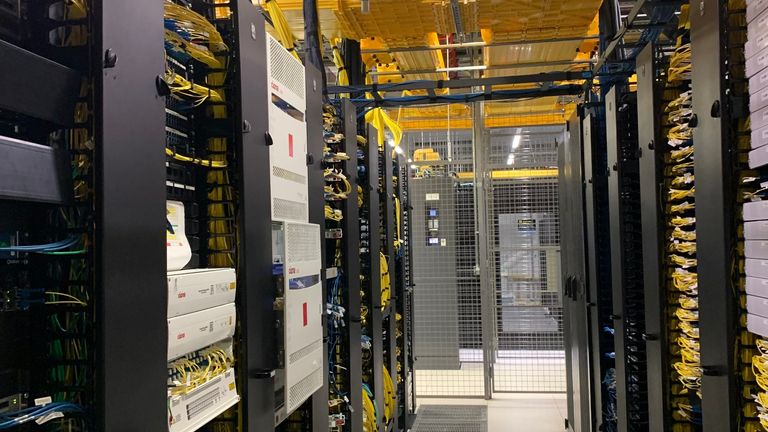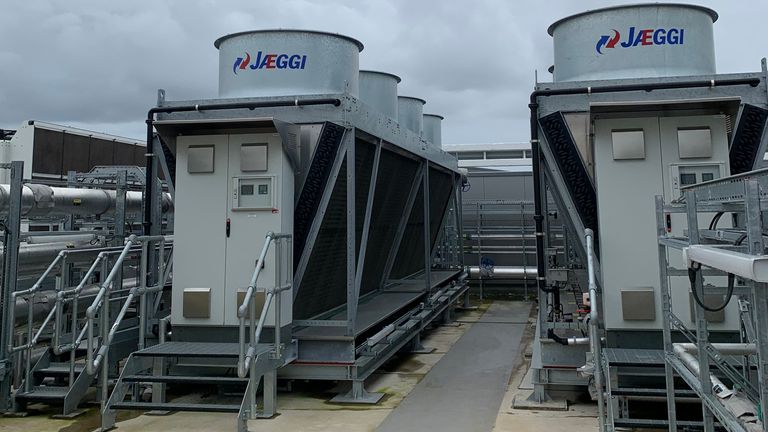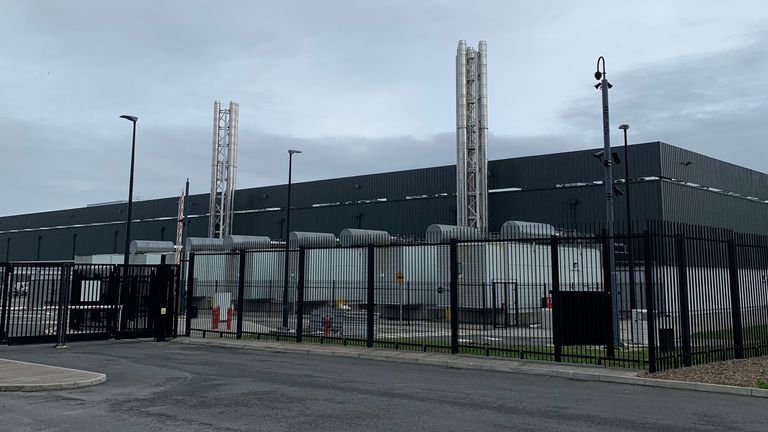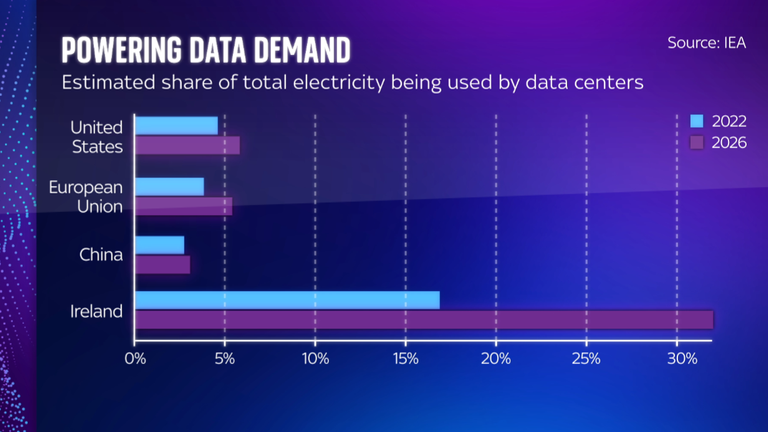What does boom in resource-hungry data centres mean for our future energy plans?
The growing power and water needs of the data industry are attracting increased scrutiny as demand for low carbon energy increases across society.
Thursday 28 March 2024 03:23, UK
"Come friendly bombs and fall on Slough!" wrote poet John Betjeman in 1937.
The scruffy trading estate west of London may only have got uglier since. But it's definitely not somewhere you'd want to obliterate.
Slough is now Europe's largest data hub and the second largest in the world.
Nearly every foreign exchange transaction passes through a single data centre here.
Others handle 95% of card purchases in the capital, not to mention the majority of data traffic on the global internet, from AI models to cat videos.
And that demand is growing - by around 35% a year according to industry data.
But the computers processing that data - especially the ones running AI models - are demanding increasing amounts of resources.
Electrical power to run the servers, but also water - and yet more power - to run the vast cooling systems needed to keep the online world running.
The latest analysis by the International Energy Agency (IEA) forecasts global power demand for data centres will double by 2026.
This week, the CEO of National Grid John Pettigrew warned electricity demand from data centres in the UK would increase six-fold in the next decade requiring "bold action" to adapt the power grid accordingly.
"It is a big part of our business," says Bruce Owen, managing director of Equinix in the UK.
Of the 32 data centre companies in Slough, Equinix is largest.
A so-called "co-location" provider, it sites data centres closest to users and either provides servers for customers or rents space for their own.
Like most of the industry, they have zero carbon energy targets.
"Ninety-six percent of what we do would be covered by wind and solar, and we're well on track to get to 100% by 2030," says Mr Owen.
The big tech companies have similar net-zero electricity and water pledges too.
But given demand for low carbon energy and water is increasing across society, the impact of the booming data industry is still attracting scrutiny.
Data from Microsoft, Google and Meta reveals their energy and water demands globally rival those of small countries.
And while they're becoming more transparent - though not all, Amazon, the world's leading cloud computing provider doesn't publish data on its environmental footprint - it's hard to independently assess what parts of their businesses are leading to the highest demand for resources.
The problem is particularly acute in Ireland. The low-tax hub for big tech firms in Europe, Ireland is home to 82 data centres, the majority on the outskirts of Dublin.
According to the IEA, data centres will account for a third of Ireland's electricity demand by 2026.
Recently, Ireland's power grid provider warned of the risks of blackouts if constraints weren't put on data centre development.
The industry argues responsibility for the issue lies as much with the Irish government - responsible for improving access to low-carbon sources of energy - as with the industry.
"The focus really needs to be on generation of energy. And that's where we have failed," says Michael McCarthy, director of industry group Cloud Infrastructure Ireland.
Mr McCarthy argues data centre operators can help in the decarbonisation of Ireland's grid through "power purchase agreements" for 100% renewable power, providing certainty for generators.
'Regulate it like a public utility'
But campaigners point out the demand is still there, and from users of energy that aren't transparent about their operations.
"We need data centres, COVID made it very evident that they're a vital part of our society," says Dylan Murphy, from Dublin environmental campaign group Not Here Not Anywhere.
"But they need to be done in a sustainable way. They need to be treated like utilities rather than private enterprises.
"The internet is a public utility. Now we need to see data centres as these public utilities and regulated as such."
The situation is changing.
The EU is requiring data centre operators to publish detailed reports on their energy and water demand for each of the sites they operate and their efficiency improvements.
The US is seeing similar demands with planning restrictions being imposed by some states where energy, or water resources are constrained.
But the increase in demand for limited supplies of low-carbon energy doesn't look set to drop anytime soon. It may even increase further.
This month leading chip maker Nvidia unveiled its latest GB200 chip assembly for training the AI models of the future. Although it's 25% more efficient in terms of computing power as a function of electricity required, its power needs are huge.
One GB200 unit consumes a staggering 1.2 kilowatts of energy - that's 12 times the power needs of a decent laptop.
Given much of the latest growth in data centre and energy demand is for training AI models - it does raise the question of what society is getting in return for the natural resources needed.
"It's really important to challenge the narratives here," says Dr Mhairi Aitken, who studies the ethics of AI at The Alan Turing Institute.
The trend among Big Tech is currently the pursuit of larger and larger AI models with potentially huge power requirements.
"That's not necessarily the way that we're going to maximise the value of AI," says Dr Aitken.
"We might think instead about how we can improve the efficiency of models or how we can develop smaller models with less of an environmental impact, less of a carbon footprint and less of a water footprint."
The internet may have radically improved society since Betjeman was slagging off Slough.
But it might be time to ask what we can expect to see in return for the surging demand a few powerful companies are placing on our shared natural resources.





